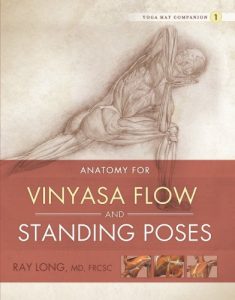The Mat Companion series is designed to assist you in understanding
the functional anatomy of yoga. Although all yoga poses are interrelated, for learning purposes we have subdivided them into categories according to their general form. This first book of the series shows how to combine Western scientific knowedge with the practice of Vinyasa Flow and the standing poses. In Vinyasa we repeat a foundational series of postures that encircle individual asanas from the other pose categories. This vigorous and aerobic practice combines breathing and body movement to produce heat, warming up the muscles, tendons, and ligaments and generating a detoxifying sweat. Practicing Vinyasa in a heated room enhances these effects. In the first part of this book, we discuss the practical application of Western science to Vinyasa Flow.
Following the Vinyasa portion of the book are the standing poses. Learning Hatha Yoga begins with these fundamental postures, which stretch and strengthen the muscles of the lower extremities and open the hips and pelvis. As a result of this practice, activities of daily living, such as standing and walking, feel comfortable and easy. Working the muscles and joints of the lower extremities also stimulates the nerve centers that supply this region, increasing electrical activity in the lumbosacral plexus. This increased electrical activity in turn illuminates the first and second chakras of the subtle body, aiding to remove energetic blockages that develop throughout our lifetime. It is this combination of biomechanical, physiological, and energetic processes that differentiate yoga from other forms of physical activity.
the functional anatomy of yoga. Although all yoga poses are interrelated, for learning purposes we have subdivided them into categories according to their general form. This first book of the series shows how to combine Western scientific knowedge with the practice of Vinyasa Flow and the standing poses. In Vinyasa we repeat a foundational series of postures that encircle individual asanas from the other pose categories. This vigorous and aerobic practice combines breathing and body movement to produce heat, warming up the muscles, tendons, and ligaments and generating a detoxifying sweat. Practicing Vinyasa in a heated room enhances these effects. In the first part of this book, we discuss the practical application of Western science to Vinyasa Flow.
Following the Vinyasa portion of the book are the standing poses. Learning Hatha Yoga begins with these fundamental postures, which stretch and strengthen the muscles of the lower extremities and open the hips and pelvis. As a result of this practice, activities of daily living, such as standing and walking, feel comfortable and easy. Working the muscles and joints of the lower extremities also stimulates the nerve centers that supply this region, increasing electrical activity in the lumbosacral plexus. This increased electrical activity in turn illuminates the first and second chakras of the subtle body, aiding to remove energetic blockages that develop throughout our lifetime. It is this combination of biomechanical, physiological, and energetic processes that differentiate yoga from other forms of physical activity.






